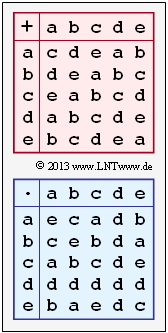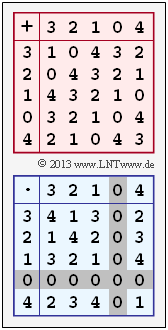As in the "Exercise 2.2" we consider a finite field of order $q = 5$ and thus the Galois field
- $$\rm GF(5) = \{{a}, { b},{c},{d},{e}\}\hspace{0.05cm}.$$
No further statements are made about the elements. They can be integers or any mathematical expressions.
The Galois field is determined exclusively by
- an addition table modulo 5,
- a multiplication table modulo 5.
The main properties of a Galois field are compiled on the "first theory page". There, reference is made to
- the commutative and distributive laws,
- the neutral elements of addition and multiplication,
- the inverse elements of addition and multiplication, and
- the determination of primitive elements.
In the present example $\beta$ would be a primitive element if $\beta^2, \ \beta^3$ and $\beta^4$ $($in general: $\beta^{q-1})$ yield the remaining elements of the Galois field $\rm GF(5)$ except for the zero element.
Hint: The exercise is related to the topic of the chapter "Some Basics of Algebra".
Questions
Solution
- $$z_i + N_{\rm A} = N_{\rm A} + z_i = z_i\hspace{0.05cm}.$$
- From the addition table it follows $N_{\rm A} \ \underline{= \rm d}$.
(2) In contrast, for all elements $z_i (i = 1,\hspace{0.05cm}\text{ ...} \hspace{0.1cm} , \ q-1)$, the neutral element of multiplication $(N_{\rm M})$ satisfies the following condition:
- $$z_i \cdot N_{\rm M} = N_{\rm M}\cdot z_i = z_i\hspace{0.05cm}.$$
- From the multiplication table, one can see $N_{\rm M} \ \underline{= \rm c}$.
(3) The commutative law is satisfied for this Galois field in both cases (addition and multiplication),
since the addition table and multiplication table are each symmetric about the table diagonal.
(4) Let us first consider the first expression. If the distributive law is valid, it must hold:
- $$\rm a \cdot (b+c) = a \cdot b+ a \cdot c \hspace{0.05cm}.$$
- For the left side you get:
- $$\rm a \cdot (b+c) = a \cdot a =e \hspace{0.05cm},$$
- and for the right side:
- $$\rm a \cdot b+ a \cdot c = c + a = e\hspace{0.05cm}.$$
- The distributive law is satisfied here as well as for the other two given expressions:
- $$\rm d \cdot (b+c) \hspace{-0.1cm} \ = \ \hspace{-0.1cm} d \cdot a =d \hspace{0.05cm}, \hspace{0.5cm}d \cdot b+ d \cdot c = d + d = d\hspace{0.05cm},$$
- $$\rm e \cdot (a+c) \hspace{-0.1cm} \ = \ \hspace{-0.1cm} e \cdot e =c \hspace{0.05cm}, \hspace{0.5cm}e \cdot a+ e \cdot c = b + e = c\hspace{0.05cm}.$$
All proposed solutions apply.
(5) The zero element $N_{\rm A} = \rm d$ becomes $N_{\rm A} = 0 \ \Rightarrow \ \rm d = 0$, the identity element $N_{\rm M} = \rm c$ becomes $N_{\rm M} = 1 \ \Rightarrow \ \rm c = 1$.
- The other elements $\rm a, \ b$ and $\rm e$ can be determined modulo $5$ from the addition table or the multiplication table. For example, from the first row of the addition table follows
- $$\rm (a + b) \hspace{0.1cm}{\rm mod} \hspace{0.1cm} 5 = d = 0 \hspace{0.05cm}.$$
- Since both $\rm a$ and $\rm b$ cannot be $0$ or $1$ (since these are already assigned for $\rm c$ and $\rm d$ ), the inference is:
- $$\rm a = 2, \hspace{0.3cm} b = 3 \hspace{0.5cm}{\rm or}\hspace{0.5cm} a = 3, \hspace{0.3cm} b = 2\hspace{0.05cm}.$$
- For example, from the second row of the addition table it follows:
- $$\rm (b + b) \hspace{0.1cm}{\rm mod} \hspace{0.1cm} 5 = e \hspace{0.05cm}.$$
- From $\rm b = 3$ would result $\rm e = 1$. But this is again not possible, because already $\rm c = 1$ has been defined.
- So you get as a final result:
- $$\rm a \hspace{0.15cm}\underline{= 3}\hspace{0.05cm},\hspace{0.2cm}b \hspace{0.15cm}\underline{= 2}\hspace{0.05cm},\hspace{0.2cm} c \hspace{0.15cm}\underline{= 1}\hspace{0.05cm},\hspace{0.2cm}d \hspace{0.15cm}\underline{= 0}\hspace{0.05cm},\hspace{0.2cm} e \hspace{0.15cm}\underline{= 4}\hspace{0.05cm}.$$
The graph shows the addition and multiplication table for this set of numbers.
(6) True are the statements 1 and 4:
- In the addition table, one recognizes exactly one $\rm d = 0$ in each row and column. That is:
- For all $z_i ∈ \{0, \, 1, \, 2, \, 3, \, 4\}$ there exists a unique additive inverse.
- The multiplicative inverse can be recognized in the multiplication table by the entry $\rm c = 1$. The multiplicative inverses are as follows:
- $${\rm Row \hspace{0.15cm}1\text{:}}\hspace{0.25cm} {\rm Inv_M}(a=3) \hspace{-0.15cm} \ = \ \hspace{-0.15cm} \rm b = 2 \hspace{0.05cm},$$
- $${\rm Row\hspace{0.15cm} 2\text{:}}\hspace{0.25cm} {\rm Inv_M}(b=2) \hspace{-0.15cm} \ = \ \hspace{-0.15cm} \rm a=3 \hspace{0.05cm},$$
- $${\rm Row\hspace{0.15cm} 3\text{:}}\hspace{0.25cm} {\rm Inv_M}(c=1) \hspace{-0.15cm} \ = \ \hspace{-0.15cm} \rm c=1 \hspace{0.05cm},$$
- $${\rm Row\hspace{0.15cm} 5\text{:}}\hspace{0.25cm} {\rm Inv_M}(e=4) \hspace{-0.15cm} \ = \ \hspace{-0.15cm} \rm e=4 \hspace{0.05cm}.$$
- For the zero element $\rm d = 0$ on the other hand, no multiplicative inverse exists.
(7) Concerning the primitive elements one obtains
- $$\rm a \hspace{-0.15cm} \ = \ \hspace{-0.15cm} 3 \hspace{0.05cm},\hspace{0.2cm} a^2 = 9 \hspace{0.1cm}{\rm mod} \hspace{0.1cm} 5 = 4 \hspace{0.05cm},\hspace{0.2cm} a^3 = 27 \hspace{0.1cm}{\rm mod} \hspace{0.1cm} 5 = 2\hspace{0.05cm},\hspace{0.2cm} a^4 = 81 \hspace{0.1cm}{\rm mod} \hspace{0.1cm} 5 = 1\hspace{0.13cm} \Rightarrow \hspace{0.13cm}{\rm primitive}\hspace{0.05cm},$$
- $$\rm b \hspace{-0.15cm} \ = \ \hspace{-0.15cm} 2 \hspace{0.05cm},\hspace{0.2cm} b^2 = 4 \hspace{0.05cm},\hspace{0.2cm} b^3 = 8 \hspace{0.1cm}{\rm mod} \hspace{0.1cm} 5 = 3\hspace{0.05cm},\hspace{0.2cm} b^4 = 16 \hspace{0.1cm}{\rm mod} \hspace{0.1cm} 5 = 1\hspace{0.13cm} \Rightarrow \hspace{0.13cm}{\rm primitive}\hspace{0.05cm},$$
- $$\rm e \hspace{-0.15cm} \ = \ \hspace{-0.15cm} 4 \hspace{0.05cm},\hspace{0.2cm} e^2 = 16 \hspace{0.1cm}{\rm mod} \hspace{0.1cm} 5 = 1 \hspace{0.05cm},\hspace{0.2cm} e^3 = \hspace{0.05cm} ...\hspace{0.05cm}= 4\hspace{0.05cm},\hspace{0.2cm} e^4 =\hspace{0.05cm} ...\hspace{0.05cm} = 1\hspace{0.13cm} \Rightarrow \hspace{0.13cm}{\rm not\hspace{0.15cm} primitive}\hspace{0.05cm}.$$
- From the set $Z_5 = \{0, \, 1, \, 2, \, 3, \, 4\}$ ⇒ "$2$" and "$3$" are primitive elements ⇒ solution suggestions 1 and 2.

